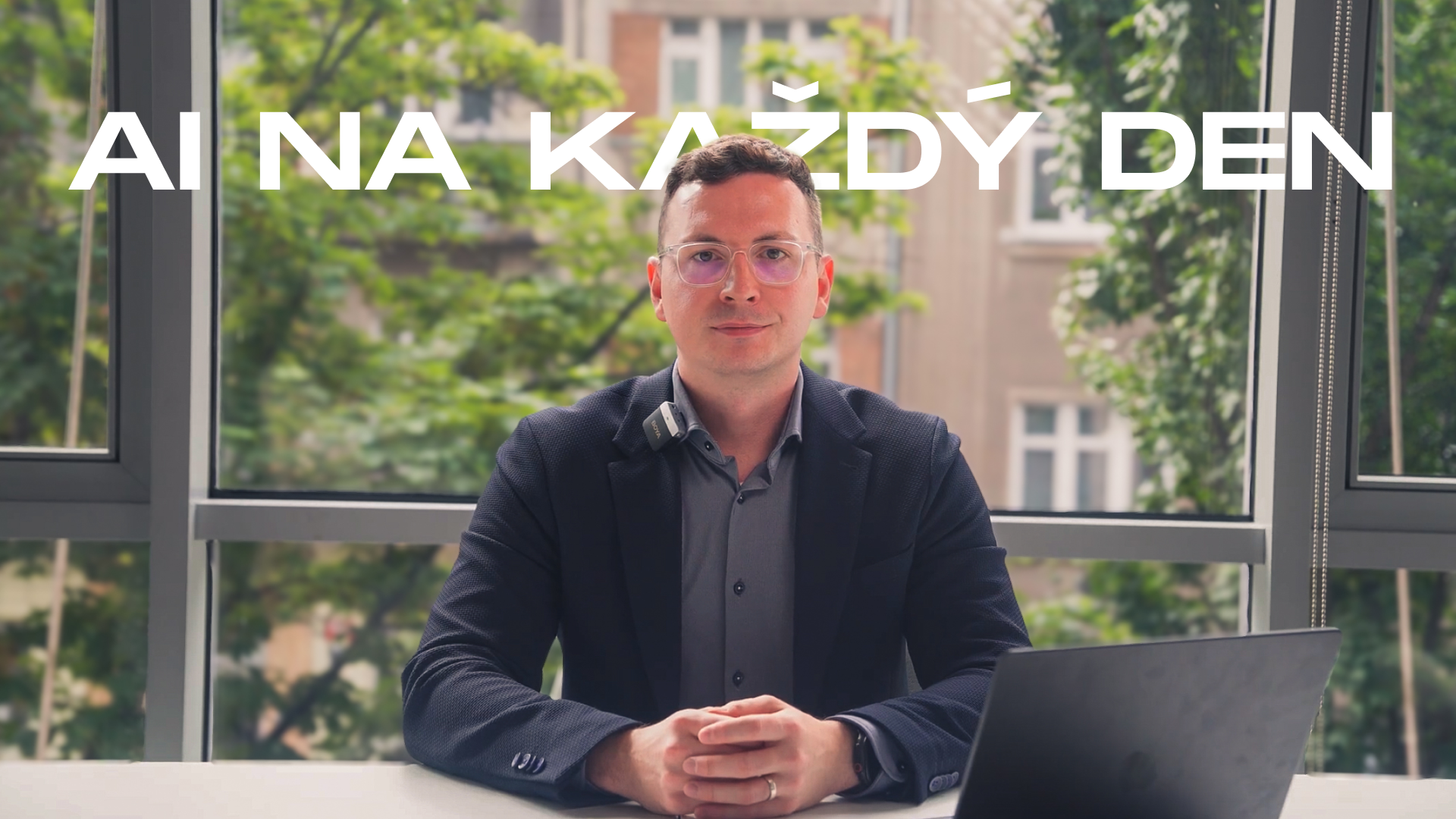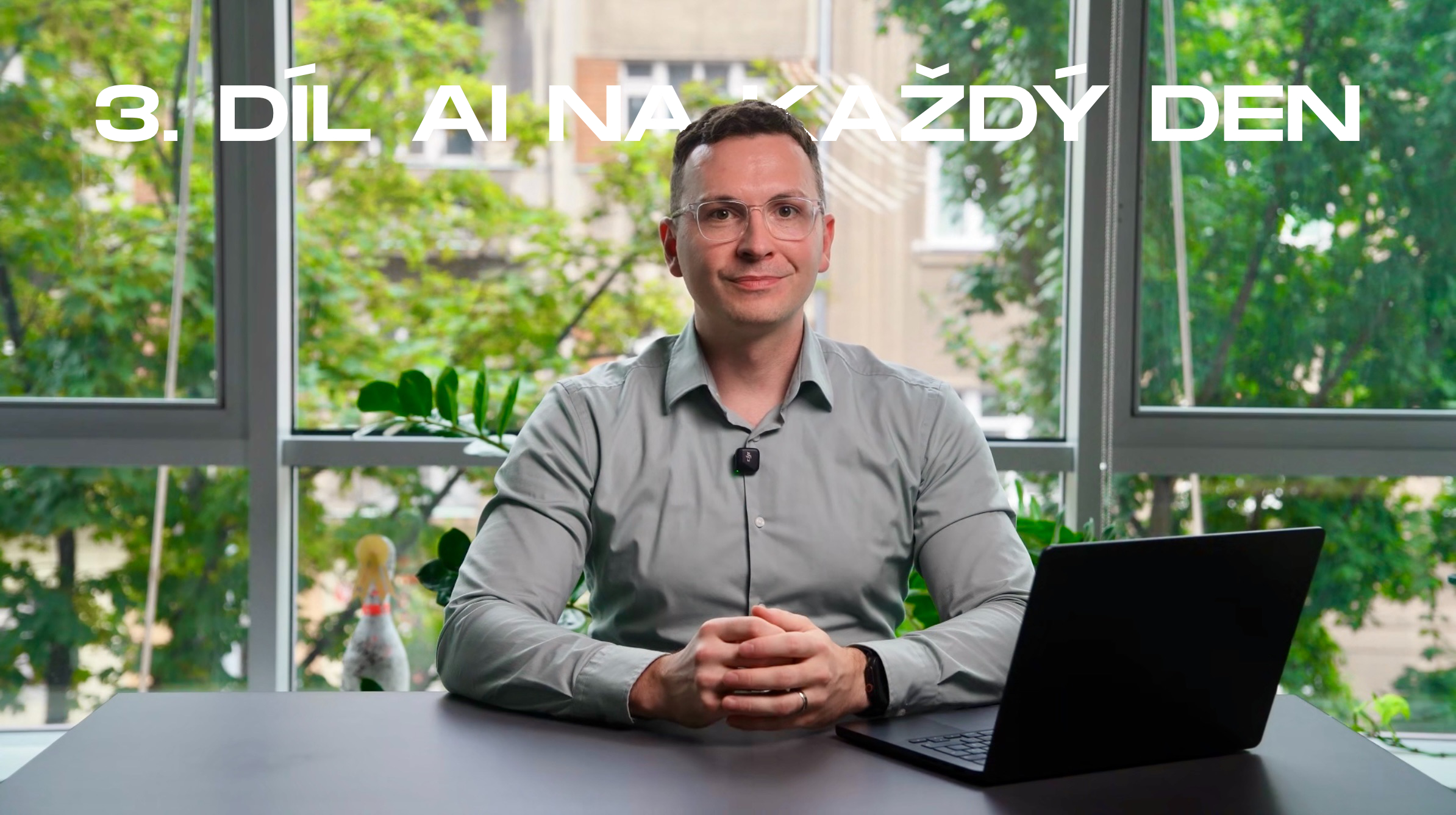Welcome to the first episode of the “AI for Every Day” series, which will guide you through the practical use of artificial intelligence in everyday work and personal life.
Artificial intelligence is no longer just a thing of the future – today it can be found in search engines, mobile apps, customer support and office tools. Yet there’s a lot of uncertainty around it, and many people are still afraid of it or don’t know how to get started.
This series is being created for two reasons: we consider the practical tips of our colleague Tomáš Rolc to be so beneficial within the company that we decided to share them with you. At the same time, we are constantly looking for new ways to integrate AI into our services and SmartFP platform in a meaningful way.
Tomáš Rolc will guide you through the series
Tomáš Rolc works at Gappex, where he is responsible for the business development of SmartFP – a corporate low-code platform for process digitalization. His professional career combines technical and business experience: for ten years he worked as a freelance developer, focusing on enterprise systems, websites and digital solutions. For the last two years, he has been intensively involved in the business and development of SmartFP with the aim of bringing the tool to the widest possible range of users.

More about Tomas
In addition to his work, he is also involved in public affairs as a representative of the town of Roztoky. Working with extensive documentation and the need to quickly navigate through texts has shown him the practical advantages of artificial intelligence. For him, AI is not an academic topic, but a tool of everyday practice – it helps him save time, manage routine tasks, work more efficiently and also more creatively.
Tomáš does not profile himself as an expert in artificial intelligence, but as an ordinary user who has gradually mastered various ways of using it at work and outside of it. It is this practical perspective that he brings to this series – showing how AI can help people who want to simplify their work, gain a new perspective and not get lost in the digital world.
In the following lines, we give the floor directly to Tomáš – because he knows best how to get started with AI, how to integrate it into your daily routine and what to realistically expect from it.
Video for this episode of the series
Let’s take a look together at how AI can make your work and life easier
The purpose of this episode is to answer the questions that everyone who starts with AI asks. I want to show that AI can be a great helper – making routine tasks easier, opening up new possibilities, and allowing you to focus on more important work. You don’t have to be afraid of it, but it’s important to understand what to expect from it – and what not to expect.
The basic rule of thumb is: the best is not AI alone, but a combination of AI and humans. Artificial intelligence is often faster at analysis, can suggest a solution or formulate an answer. But without a clear brief, goal and control from a human, it cannot stand on its own.
In practice, it works best when a human sets the direction and AI helps along the way – looking for options, evaluating, suggesting.
The AI won’t do the work for you. But if you use it right, it can help you be significantly more efficient – faster, more consistent, sometimes even more creative. And that’s where its real benefit lies.
BEFORE YOU BEGIN
All tips and examples given here are for illustration purposes only and may not be appropriate for your specific work environment. Any use of AI should first be discussed with your corporate IT department and cybersecurity experts.
I am not encouraging you to put private or company documents into AI tools – always act in accordance with your organisation’s policies and internal guidelines.
Questions that everyone who starts with AI asks:
- How to navigate AI tools
- What is and what is not generative AI
- What you need to get started with AI
- What possibilities AI gives you and what to use it for
- Why not to worry about AI – fear for data, work, copyright law
- Isn’t it awkward or dangerous to use AI?
Questions that everyone who starts with AI asks themselves 1/6:
How to navigate AI tools
When one first looks at the range of AI tools on offer, it can seem like a cluttered mess. ChatGPT, Claude, Perplexity, Copilot, NotebookLM, Recraft… Each tool looks different, has different features, and it’s hard to know what’s for what. It helps if we get a basic order and separate the tools:
1. By purpose and versatility
First, you’ll notice that some tools handle multiple things at once, while others are focused on one specific task.
Multifunctional AI tools (e.g. ChatGPT, Claude, Copilot) can generate text, answer questions, translate, summarize documents, write code, and sometimes even create images or tables. They are such versatile assistants.
Specialized AI tools focus on one area – for example:
- Recraft AI – graphics and design,
- ElevenLabs – text-to-speech (voice AI),
- HeyGen and Sora – video,
They are like tools in the workshop – while a multi-tool knife helps you “somehow” solve more things, with a specialised screwdriver you know exactly what to expect.
Example of moving an image generated in Recraft.ai using Sora.


2. By technology and “engine” under the hood
Every AI tool runs on a model – much like a car runs on an engine.
In generative AI, this “engine” is usually a language model (LLM – Large Language Model).
For example:
- ChatGPT runs on OpenAI’s GPT models
- Claude uses models from Anthropic
- Gemini is a model from Google
- LLaMA is a model from Meta
It is this model that determines how well a tool understands, responds to, creates or analyses a text. Two tools may look similar, but if they have a different “engine”, the result may be different.
3. By method of use
Integrated AI tools can be found directly in common applications – for example: the Microsoft Copilot in Office (Word, Excel, PowerPoint). They work silently “in the background” and help without the need to run a separate application.
Standalone AI tools work over the web – just open a browser and get started: ChatGPT, Claude, Perplexity, Recraft AI, Gamma.app… These tools tend to be more versatile and have a wider range of settings and uses.
Questions that everyone who starts with AI asks 2/6:
What is and what is not generative AI
Generative AI is a type of artificial intelligence that can create new content – text, images, code or sound – based on input data (e.g. questions or instructions). Typically, it uses so-called Large Language Models (LLM), which have been trained on huge amounts of text.
Such a model does not search the database for an answer, but generates the most likely continuation of the text. This makes it appear as if it is “thinking” – but in reality it does not understand the meaning and does not possess consciousness or emotion.
What generative AI is not:
- He is not a fact finder – he can make up information (“hallucinate”).
- He is not a reliable expert – he may answer a little differently each time.
- It is not traditional software – it does not always give the same output to the same input.
Imagine AI as a colleague. An average colleague who sometimes has great ideas, sometimes completely off. A colleague to whom you have to give a task, check the result and sometimes correct it. But also a colleague who never talks back, has unlimited capacity and works whenever you remember.
The questions that everyone who starts with AI asks 3/6:
What you need to get started with AI
Surprisingly few! If you can send an email or search for something on Google, you already have almost everything you need:
- Computer or phone with internet connection
- Web browser (Chrome, Firefox, Edge)
- Email for registration (most services only require basic registration)
- Basic knowledge of working with the Internet
- The desire to make your work easier
Most AI tools work directly in the web browser, so you don’t need to install anything. Many of them are free to get started – just sign up like any other website.
Questions that everyone who starts with AI asks on 4/6:
What possibilities AI gives you and what to use it for
Today, AI exists for almost anything – from administration to creative activities to analysing complex data. There are a lot of tools out there, and their use is expanding rapidly. If you’re not sure if there’s already a suitable AI for your particular case, I recommend the website There’s an AI for Thatwhere you can easily find out which tool is right for the job – or if there is one at all.
Below you’ll find some specific areas where AI can be put to good use, as well as tips on tools that are worthwhile. Each of these can save you time, simplify your work, or bring a whole new perspective. It’s not a complete list of everything out there, more like a little signpost of where you can start with AI and what you might want to try.
Working with text
- Writing emails, letters, notifications – AI helps you formulate even complex texts
- Summarizing long documents – instead of reading a 50-page report, you get a 2-page summary
- Translations – not only between languages, but also “translation” of professional text into comprehensible Czech
- Proofreading and editing – AI corrects spelling, grammar and style
Working with files
- Extracting data from invoices – AI pulls variable symbols, amounts, items
- Contract analysis – alerts you to important points or risks
- Form processing – auto-fill or completeness check
Working with images
- Creating graphics for presentations – consistent visual style according to the brand manual
- Photo editing – background removal, resizing, basic retouching
- Creating illustrations – when you need a picture and don’t have a photographer
Working with sound
- Transcription of recordings to text – minutes of meetings, interviews, phone calls
- Text to sound – for those who learn better by listening
- Cleaning audio recordings – removing noise, improving quality
AI summary of this article created in Perplexity and read using ElevenLabs.
Working with video
- Creating explainer videos – using avatars if you’re camera shy
- Video subtitling – automatic subtitle generation
- Summary of the long videos – highlights from the hour-long lectures
As a personal assistant
- Planning and organization – scheduling, task reminders
- Booking and communication – help with formulating difficult emails
- Preparation for meetings – briefing on participants, draft agenda
- Writing a follow-up – turn bullet points or Teams videos into a clear summary and list of next steps
As a lecturer and coach
- Difficult conversations training – practising dismissal, salary negotiation
- Education – explaining complex regulations, laws, procedures
- Personal development – creating a diet, training plan, skincare routine
Specific tools worth trying
It’s good to know that most AI tools come in multiple versions – they are referred to as ChatGPT-4o, Claude Sonnet 4.0 or GPT-4-turbo, for example. These designations often reflect the level of sophistication of the model (generally: the higher the number, the better the performance), but sometimes they also distinguish the focus of the model – for example, a model optimized for writing code or for reasoning.
That’s why I recommend finding out what it’s best suited for – and using it for that. Here are a few tools that I have good experience with:

Claude is great at summarizing texts and writing “utility” texts – such as meeting summaries, draft documents or official documents. If you often work with long documents, studies or reports, Claude will process them quickly and clearly so you can decide what to pay attention to.

ChatGPT by OpenAI is great for common tasks, brainstorming and idea generation. It can help you structure ideas, design a strategy or come up with texts. It’s a versatile helper, suitable for most situations where you need to create or think something quickly.

Perplexity has replaced Google for me. It searches for current information on the web and summarizes it straight into a clear answer. The Deep Research feature is great for detailed research. Google is starting to test similar summaries, so you may notice AI answers in search results as well.

NotebookLM is a useful tool for working with large amounts of documents. You upload your documents and can “query” them for content. It can also summarize long YouTube videos or convert audio to text, saving time when processing information.

ElevenLabs converts any text into natural sounding speech. Great for the car, for example – you can have an article, email or professional text “read” to you while on the road. Very useful if you need to use your time away from the screen effectively.

HeyGen is a tool for creating videos using AI avatars. These avatars can read out text or synchronously dub the spoken word that you provide to them in the form of an audio recording.
The AI integrated in SmartFP was developed in collaboration with Algotech. It leverages the latest advanced LLM models and helps users find answers in contracts and other documents. It works exclusively with the data sources made available to it, providing employees with relevant and reliable information directly within our platform.
Questions that everyone who starts with AI asks 5/6:
Why not to worry about AI – fear for data, work, copyright law
With every new technology comes uncertainty and apprehension – that’s only natural. This is doubly true for artificial intelligence, as it works with information we give it and often solves tasks that were previously handled by humans. Let’s briefly go over the three most common fears and tell you why they shouldn’t deter you from giving AI a try.
Data security
Using AI is essentially as safe as writing an email or using online banking.
Just follow a few basic rules:
- Don’t put sensitive data into AI – passwords, card numbers, personal client information or confidential company documents.
- For everyday work with texts, ideas, images or research, AI is completely safe.
- If you work with more sensitive data, check the terms of use. Reputable tools (e.g. ChatGPT in the paid version) explicitly guarantee that they do not store or use your data to further train the model.
Good to know
AI in SmartFP can – like the entire platform – be run on its own infrastructure. This way, data doesn’t leave the company and remains fully under your control.
Will AI take our jobs?
Yes, AI is changing the way we work – but that doesn’t mean it’s “taking people’s jobs”. Rather, it automates some tasks, making room for others. Just like the industrial revolution – some professions will disappear, others will transform and many new ones will emerge.
AI will not replace entire professions, but rather repetitive routine activities. If much of your job is about copying, transcribing or finding information, it’s the perfect time to start thinking about how to delegate those parts to AI – and free your hands for what’s creative, fun or requires human judgement.
Those who learn to use AI will get a head start. Not because they do less, but because they can do more, faster. AI won’t take your job, but someone who knows how to use it might.
AI and Copyright
This is an area that is still evolving and the law is gradually responding. In general, output created by AI is not automatically protected by copyright law because there is no human author. So if you use text, an image or code generated by AI “as is”, it is not legally the same as a copyright creation.
What does this mean in practice?
If you are just using the AI output as a base and further modifying, combining or inserting it into a larger whole, it’s not a problem. For finished texts or images, I recommend not to use AI as a “copier”, but as a co-author – edit, add, adapt the result. Simply put: AI is a great tool, but you are still responsible for the outcome.
Questions that everyone who starts with AI asks on 6/6:
Isn’t it awkward or dangerous to use AI?
Using AI doesn’t make you less competent – it’s like using a calculator or a computer. No one today finds it embarrassing to calculate on a calculator instead of in their head or type on a computer instead of a typewriter.
Generative AI is a technology that will stay with us, for better or worse, and it makes no sense to dismiss it or wait it out. On the contrary, it’s a good idea: to explore its possibilities, to try to understand them, and to wait for the tools that will bring real practical applications.
AI is a tool, not a threat. Just like learning to use new versions of Excel or new accounting software, learn to use AI. It’s an investment in your future competitiveness.
Start slowly, experiment and don’t be afraid to make mistakes. You won’t “break” the AI with the wrong question, and if it doesn’t answer correctly, try asking a different question. The best way to understand AI is to start using it.
An example of an avatar video created with HeyGen and ElevenLabs.
What to take away from this piece
AI is a tool, not a threat, and you don’t have to be an expert to start using it. The sooner you start using AI, the better.
AI alone is not good, AI needs a human to stand at the beginning and at the end, think of AI as an average colleague to whom you delegate parts of the task and still be in the loop – the big picture is still up to the human.
What awaits us in the next episodes
In future episodes, we will focus on specific areas where AI can be used effectively. Each episode will have a clear theme, practical examples and simple exercises that you can try out for yourself.
You can look forward to the following topics:
- How to create text, images, audio and video with AI tools
- How to use AI to create presentations or websites
- How AI can help in HR, marketing, customer support or data analysis
- How to use AI in everyday life – for planning, organising or learning
- and others
Each episode is also accompanied by a video with a practical demonstration and recommendation of specific tools, including their comparison by availability, English or price.
You can look forward to the next episode again on Friday, namely 13. 6. 2025. The topic will be working with text using AI. Subscribe so you don’t miss anything:
Recommendations in conclusion
Watch the video where I briefly introduce the topics of the series and offer some tips on how to get started with AI today – without complicated installation and for free.
And if you have an idea for a particular topic that you’d be interested in, I’d be happy to hear from you. I’m creating this series for you – and with you.




